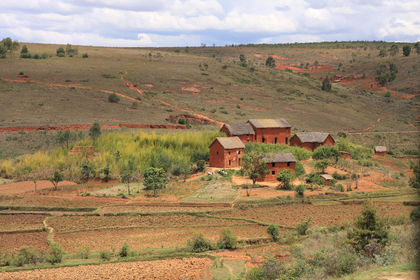MADAGASCAR

Democratic Republic of Madagascar
République Démocratique de Madagascar
Repoblika Demokratika n'i Madagaskar
COUNTRY OVERVIEW
LOCATION AND SIZE.
Madagascar lies in the southern Indian Ocean some 400 miles off Africa's eastern shore. With a land area of 587,039 square kilometers (226,656 square miles) Madagascar is a little less than twice the size of Arizona. It is also the world's fourth largest island, with a coastline of 4,827 kilometers (3,000 miles). Madagascar's capital is Antananarivo (population 2 million), located on its central plateau 1,468 meters (4,816 feet) above sea level. Other major cities include Fianarantsoa (population 440,000), inland in the southern part of the island; Taomasina (population 330,000), the principal port, located on the eastern seaboard; Antsiranana (population 320,000), at its northern-most tip; and Mahajanga (population 295,000), site of the country's second international airport. Madagascar's highest point is a mountain called Maromokotro (2,876 meters or 9,436 feet), located in the Tsaratanana Massif region along the island's central spine.
POPULATION.
Demographic statistics for Madagascar are scarce and often unreliable, but a mid-2000 estimate by the U.N. Population Fund places its population at around 15.9 million. Although relative to its size this figure is below the average of its sub-Saharan neighbors, growth is brisk. With an annual birthrate estimated at 42.92 per 1,000 of population—around 3 percent per annum for the years 1995 to 2000—the fragility of Madagascar's environment makes this expansion a significant concern. The average life expectancy at birth of 54.95 years is relatively high by sub-Saharan standards, but poverty and malnutrition are nevertheless endemic, sanitation is very poor, and disease (especially cholera and malaria) is an ever-present threat. Some 27 percent of Malagasy (the people of Madagascar) lived in urban areas in 1998, a population segment which was growing at the rapid rate of 5.6 percent a year as rural inhabitants quit the countryside for the cities.
Ethnically, Madagascar is an unusual mix. Its 2 largest ethnic groups are the Indonesian-descended Merina (26 percent) and Betsileo (12 percent), who are historically concentrated in the central highlands, including the capital. Other groups include the Arab-African Betsimisaraka (15 percent) and Tsimehety (7 percent) of the east and north, respectively; and the Antandroy, of more purely (Bantu) African origin, in the south (5 percent). The prevalence of a unified language, the Malay-Indonesian Malagasy, has tended to work against sharp ethnic divisions, though there is some on-going chafing against Merina political domination. Religiously, 52 percent of Madagascar's people hold indigenous beliefs, 41 percent are Christian and 7 percent Muslim.
SERVICES
TOURISM.
Madagascar's climate, beaches (4,827 kilometers—or 3,000 miles—of them), and unique ecology (Madagascar is home to many endangered species of flora and fauna) make tourism one of its most dynamic and promising sectors. The industry has the potential not only to create jobs and wealth, but to turn Madagascar's unusual and endangered environment into a productive asset. Interest is great, and two-thirds of the country's visitors come for eco-tourism. In 1998, tourists brought in US$92.2 million. But although visitor numbers are rising steadily (doubling since 1994), volume is still low.In 1997 Madagascar attracted less than a fifth of neighboring Mauritius's 536,000 visitors. Further development of the industry also faces significant difficulties. Air links to Europe and Asia are few and expensive, hotel facilities are sparse and inadequate, and investment is scarce. Government attempts to meet these obstacles have included rationalizing (removing inconsistencies and streamlining) the relevant laws, creating a coordinated tourist authority, and liberalizing the airline market.
FINANCIAL SERVICES.
Limitations in the financial sector continue to impede growth. The nation's assets are controlled by the central bank and 5 commercial banks, the largest of which, BNI-Credit Lyonnais, has a total asset base of US$200 million. Few Malagasy, however, qualify for these banks' services. The problem is especially acute in the rural areas where only 1.5 percent of small farmers have access to credit; the agriculture sector itself receives only 5 percent of total lending. High interest loan rates and fees have also discouraged business borrowing. The lack of a stock exchange and shareholding culture have further restricted financing options.
RETAIL.
Few in Madagascar can afford more than the bare essentials, and steady depreciation of the currency has eroded purchasing power even further. This combined with the poor condition of the country's transport network means that trade tends to be localized and retailing minimal. However, the opening of the economy has expanded the range of goods available somewhat, especially in the main urban centers like Antananarivo.
DEPENDENCIES
Madagascar has no territories or colonies.
BIBLIOGRAPHY
Brown, Mervyn. Madagascar Rediscovered: A History from Early Times to Independence. Hamden, Connecticut: Archon Books, 1979.
Covell, Maureen. Madagascar: Politics, Economics, and Society. New York: Frances Pinter, 1987.
Economist Intelligence Unit. "Country Profile: Madagascar, Mauritius, Seychelles, Comoros." <http://db.eiu.com/report_dl.asp?mode=pdf&valname=CPAMGB> . Accessed December 2000.
Economist Intelligence Unit. "Country Report: Madagascar." <http://db.eiu.com/report_dl.asp?mode=pdf&valname=CRAM GC> . Accessed December 2000.
U.S. Department of State. Country Commercial Guide: Madagascar. Washington DC: U.S. Department of State, 2001. <http://www.state.gov/www/about_state/business/com_guides/2001/africa/madagascar_ccg2001.pdf> . Accessed December 2000.
U.S. Library of Congress. "Country Studies: Madagascar (1994)." <http://lcweb2.loc.gov/frd/cs/mgtoc.html#mg0006> . Accessed December 2000.
—Alexander Schubert
CAPITAL:
Antananarivo.
MONETARY UNIT:
Malagasy franc (FMG). One franc equals 100 centimes. Coins come in denominations of 1, 2, 5, 10, 20, 25, 50, 100, and 250. Paper currency includes denominations of 500, 1,000, 2,500, 5,000, 10,000, and 25,000 FMG.
CHIEF EXPORTS:
Coffee, vanilla, cloves, shellfish, sugar, petroleum products, clothing and textiles.
CHIEF IMPORTS:
Manufactured and consumer goods, petroleum, food.
GROSS DOMESTIC PRODUCT:
US$11.5 billion (purchasing power parity, 1999 est.).
BALANCE OF TRADE:
Exports: US$600 million (f.o.b., 1998 est.). Imports: US$881 million (c.i.f., 1998 est.).
this is the best best best information for my project
thanks to this page i got a sn A on my work